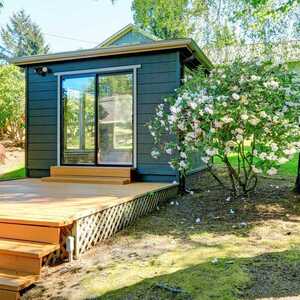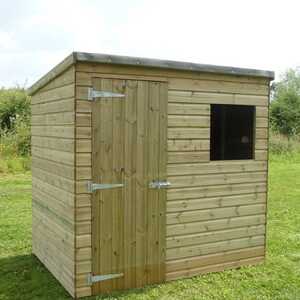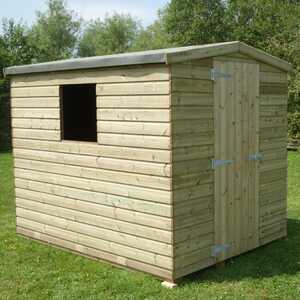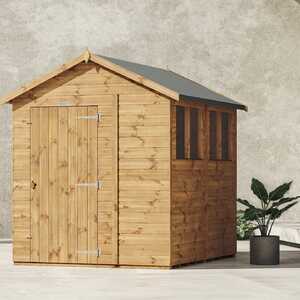Fountain Timber Guides
Outbuildings – Planning Permissions and Other Regulations
Adding a shed, greenhouse or other outbuilding to your garden can be a stylish and functional upgrade for your outdoor space – but it’s important to be aware of the planning and building regulations that may apply.
In many cases, these types of structures fall under Permitted Development and do not require planning permission. However, specific limits on size, height, position, and use must be met, especially if you live in a conservation area or similar protected setting.
Planning permission rules for outbuildings
Most domestic sheds and garden buildings can be installed without planning permission, provided they meet certain criteria. The building must only be used for purposes related to the house – such as storage, hobbies or home working – and not as separate living accommodation or a base for a noisy or disruptive business.
The total ground area of all outbuildings (excluding the original house) must not exceed 50% of the total land around the property. These buildings cannot be placed in front of the house or its side if that side faces a road. The maximum overall height is 4 metres for buildings with dual-pitched roofs and 3 metres for other roof types. If the building is within 2 metres of the boundary, the maximum eaves height is limited to 2.5 metres.
Additional restrictions apply if the site adjoins a road at the rear. Outbuildings must be at least 3.5 metres from the rear boundary in this case. Also, if the structure is intended for keeping pigeons, permission will be required regardless of its size or location.
Extra conditions for protected locations
Planning rules become more restrictive in designated areas such as National Parks, Areas of Outstanding Natural Beauty (AONBs), World Heritage Sites and Conservation Areas.
If your house falls within one of these zones, buildings positioned more than 20 metres from the house must not exceed 10 square metres in floor area. Additionally, garden buildings cannot be located between the house and its boundary if you are in a Conservation Area or similar protected setting.
It’s also worth noting that some properties – particularly new-build homes – may have had their Permitted Development rights removed. Always check with your Local Planning Authority to confirm the current rules before starting any project. You can find Government guidelines on planning permission here.

Building regulations and structural compliance for outbuildings
Even if your structure qualifies as Permitted Development, you still need to consider building regulations. Most storage sheds and greenhouses are exempt, but once a building includes mains electricity or is used for anything beyond general domestic use, regulations apply.
The one requirement that affects almost every garden office or workspace is the installation of electrical systems. All electrical work must be completed by a certified electrician, and the work must comply with Part P of the building regulations. If the building is intended for sleeping, it will almost certainly require full compliance with additional safety and insulation standards.
Your Local Building Control team can advise on what’s required for your specific project. For general guidance, visit the Planning Portal’s Building Regulations section.

Creating a garden office that works for you
Garden offices have become a popular and practical way to create a focused, dedicated workspace without losing a room inside your home. With more people working remotely than ever before, many homeowners are investing in a garden building to separate work and personal life more clearly.
In most cases, a garden office can be built without planning permission under Permitted Development rules. However, the key factor is how the space will be used. Quiet, personal work like computer-based tasks usually presents no problem. But if the building will be used for anything noisy, with regular visitors, deliveries or staff, it may be considered a business premises – and would likely need formal planning approval.
If you’re unsure, it’s worth applying for pre-application advice from your local planning authority. This informal process can help you understand what permissions, if any, will be required. Even when no permission is needed, it’s good practice to speak with your neighbours and share your plans before construction begins.

High-quality sheds and garden buildings at Fountain Timber
At Fountain Timber, we offer a wide range of timber sheds and outdoor buildings to suit different needs, styles and budgets. Whether you’re looking for a secure garden store, a smart workspace, or a simple storage shed, we supply robust structures made with high-quality materials.
Our Standard Apex Shed is a versatile option with traditional styling, available in several sizes. It features ex19mm timber cladding, a fitted window for natural light, and durable tongue-and-groove flooring. The Standard Pent Shed is ideal where space is tight – its sloping roof design allows it to sit neatly against a wall or fence, and it comes with solid ironmongery and a large front window.
For added peace of mind, the Security Shed provides extra protection with features like a 6-pin barrel lock, continuous door hinge and reinforced pressure-treated timber. If flexibility is your priority, our Powersheds range offers a modular design that allows you to position doors and windows where you like during assembly – perfect for custom layouts or future relocations.
All our sheds come flat-packed for easy installation, with clear instructions and fixings included.
Explore the full range here:



How can we help?
Outbuildings, sheds and garden offices can add plenty of value to your home – both practically and financially – but it’s essential to get the legal and structural aspects right from the start. Most garden buildings are straightforward to install under existing Permitted Development rules, but every site and usage case is different.
If you're unsure whether your project needs permission or specific building regulation compliance, your local authority will be able to guide you. And if you're looking for the right materials, structure or accessories for your garden building, our team at Fountain Timber is here to help.

